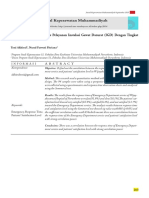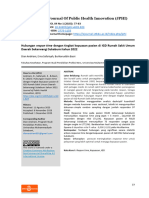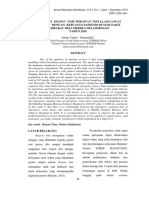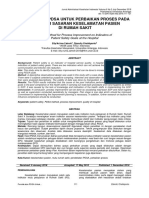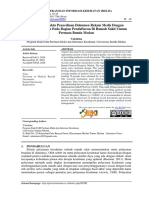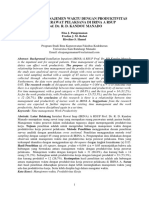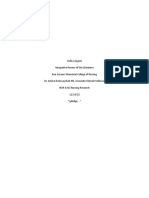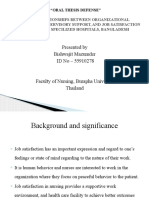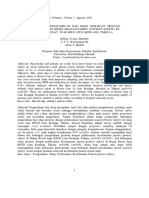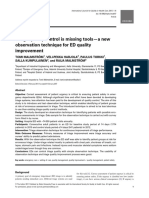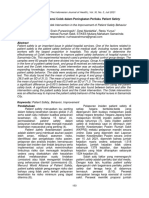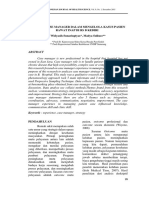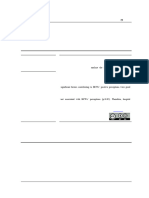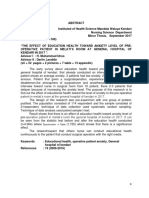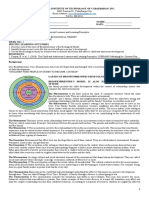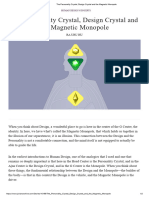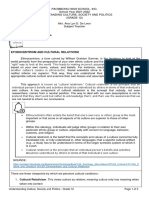Determinant of Nurses' Response Time in Emergency Department When Taking Care of A Patient
Determinant of Nurses' Response Time in Emergency Department When Taking Care of A Patient
Uploaded by
Ruly AryaCopyright:
Available Formats
Determinant of Nurses' Response Time in Emergency Department When Taking Care of A Patient
Determinant of Nurses' Response Time in Emergency Department When Taking Care of A Patient
Uploaded by
Ruly AryaOriginal Title
Copyright
Available Formats
Share this document
Did you find this document useful?
Is this content inappropriate?
Copyright:
Available Formats
Determinant of Nurses' Response Time in Emergency Department When Taking Care of A Patient
Determinant of Nurses' Response Time in Emergency Department When Taking Care of A Patient
Uploaded by
Ruly AryaCopyright:
Available Formats
Research Article
Indonesian Nursing Journal of Education and
Determinant of Nurses’ Clinic (INJEC)
125-133
Response Time in Emergency Volume 5, Issue 2, December 2020
DOI: 10.24990/injec.v5i2.305
injec.aipni-ainec.org/index.php/INJEC/index
Department When Taking Received : 2020-06-09
Accepted : 2020-07-24
Care of A Patient The Association of Indonesian Nurse
Education Center (AINEC)
Dwi Yanti Rachmasari Tartila1 , Andri Setiya Wahyudi1 , Arina Qona’ah1
Abstract
Introduction: : Response time is the handling speed calculated when the patients arrive at the hospital
until they are treated. It is influenced by several factors according to Gibson Performance Theory. The
research approach aimed to analyze individual factors including: skills, emergency training, gender, age,
length of working, and education, organizational factors: rewards, and psychological factors: nurse
motivation that influences the response time of the nurses in emergency departments at general
hospitals in Madura.
Methods: The research method used was a descriptive-analytic study with a cross-sectional
approach. The sampling technique is total sampling, which is 101 nurses. Independent variables are
skills, emergency training, gender, age, length of working, education, rewards, and motivation.
Dependent variable is response time. Data were collected using a questionnaire and direct
observations on nurses, data were analyzed using the Multiple Regression Logistic test.
Results: The results show that there was no correlation between age (p= 0.996); education (p=
0.913); length of working (p= 0.921); training (p= 0.830); skill factor (p= 0.999); and motivation factors
(p= 0.471) with response time. Whereas gender (p= 0.020); and reward factor (p = 0.020) were
related with response time.
Conclusion: In order to improve patients’ handling procedure, hospitals should give support to
nurses, like promotion or salary. Hospitals are expected to record documentations about the number
of patients according to triage category and how fast nurses handle them because it may be an
evaluation for rooms.
Keywords
gender; motivation; response time; reward; skill
INTRODUCTION functions as the main door in handling
emergency cases (Yumiati, 2017). Services in
Nursing services are an integral part of the ED have the philosophy of Time-Saving it's
health services; one of the places of service in Life-Saving, which means time is the life of the
hospitals is the Emergency Department (ED) patient. Therefore, all emergency measures are
which is a central unit of the hospital that carried out effectively and efficiently. Triage
used in Indonesian hospitals is a color triage
1
Faculty of Nursing, Airlangga University
Corresponding Author:
Andri Setiya Wahyudi, Department of Fundamental Nursing, Faculty of Nursing, Airlangga University, Surabaya, Indonesia
Universitas Airlangga Kampus C, Jl. Mulyorejo, Mulyorejo, Surabaya, Kota SBY, Jawa Timur 60115
Email: andry_remas@yahoo.co.id
http:// injec.aipni-ainec.org/index.php/INJEC/index | 125
Tartila, et al.
system. Red triage means that emergency (2014) about the factors that affect nurses’
patients need treatment as soon as possible, response time in Prof. Dr. R.D. Kandao
yellow triage is emergency patients, and green Manado’s Hospital in ED and showed that
triage means low levels of emergency and can there were 17 nurses with >5 minutes
still wait for treatment. response time.
Factors affecting response time include Gibson's theory is divided into three
internal and external factors, which may affect factors that can influence nurse performance,
tardiness on handling emergency cases. including individual factors, psychological
Furthermore, response time might also be factors, and organizational factors. Individual
affected by patient’s character, staff positioning, factors consist of ability, skills, education,
stretcher and medical staff availability, patient’s length of work, age, and gender. Psychological
arrival time, implementation of management, as factors consist of perception, attitude,
well as chosen examination and handling personality, learning, and motivation, while
strategy (Wa & Ode, 2012). organizational factors consist of resources,
Response time is the speed of treatment leadership, structure, job design, and rewards.
that is calculated when the patient arrives at The reason of using Gibson’s performance
the hospital until the patient is treated. theory in the research is because it was easy to
Response time is categorized with several understand and Gibson explained factors that
priorities, including P1(Red) for emergency may affect nurses’ performance, which is
patients with a treatment time of 0 minutes, P2 response time. The purpose of this study is to
(Yellow) for emergency patients with a determine the factors that influence
treatment time of less than 30 minutes, and P3 emergency department nurses in handling
(Green) for low emergency patients with a patients based on Gibson's Performance
treatment time of less than 60 minutes Theory.
(Permenkes, 2018).
Based on previous studies that have been MATERIALS AND METHODS
conducted by researchers from 29-30
November, 2019, it was found that there were The research design used was descriptive-
21 nurses in ED of Sumenep Hospital. The analytic with cross-sectional approach. This
lowest level of study is associate degree as research was carried out January to March
many as 16 nurses, Bachelor’s degree as many 2020, in the EDs of Madura General Hospital,
as four nurses, and postgraduate (S2) only one such as Bangkalan General Hospital, Sampang
nurse. The number of ED patient visits in 2018 General Hospital, Mohammad Noer
was 12,000 patients with the number of new Pamekasan General Hospital, and Sumenep
patient visits of 6,961 patients. Whereas in General Hospital. The sampling technique of
2019, from January to November, there were this study was total sampling, that is, all nursing
10,523 patients with a total of 5,893 new staff who served in EDs of Madura General
patients. The average number of patients per Hospital, as many as 101 nurses. Independent
day is 30 patients, so the minimum number of variables are skills, emergency training, gender,
nurses is 25 nurses if calculated based on the age, length of working, education, rewards, and
formula of nurses needed in the emergency motivation. The questionnaire ability has been
room. This shows that the number of nurses in tested in validity and reliability by Yumiati
ED of Sumenep Hospital has not met the (2017) in which questionnaire ability r value
minimum requirements. was between 0.919 to 0.943 and Cronbach’s
Some previous references showed that alpha value was 0.934. The questionnaire uses
tardiness on handling patients was still found at a Likert scale that consists of 10 questions. The
some hospitals in Indonesia. A research by reward questionnaire by Yumiati (2017) shows
Noor (2009) that talked about time response validity test for reward questionnaire gives a
on handling patients in Emergency Department result 0.829 on r value and reliability test
(ED) showed 7.45 minutes of response time, shows Cronbach’s alpha value of 0.860. The
which was the contrary of critical care questionnaire uses Likert scale with indicators
indicators, in which the response time for of financial, interpersonal, and promotion
critical patients, or P1, must be less than 0 divided into 12 questions. On the other hand,
minute. Similar research was done by Vitrise the motivation questionnaire by Yumiati (2017)
126 | pISSN: 2527-8800 eISSN: 2527-8819
Indonesian Nursing Journal of Education and Clinic (INJEC)
Table 1. Characteristic Demographic (n=101)
Category
Category Frequency
Frequency (%) (%)
Age
Age
17-25
17-25years
yearsold
old 5 5 5 5
26-35
26-35years
yearsold
old 66 66 65.3 65.3
36-45
36-45years
yearsold
old 28 28 27.7 27.7
46-55
46-55years
yearsold
old 2 2 2 2
Gender
Gender
Male
Male 69 69 68.3 68.3
Female
Female 32 32 31.7 31.7
Education
Education
Diploma
Diploma33 50 50 49.5 49.5
Bachelor
BachelorofofNursing
Nursing 49 49 48.5 48.5
Master
MasterofofNursing
Nursing 2 2 2 2
Length
Lengthofofworking
working
<5
<5years
years 44 44 43.6 43.6
5-10
5-10years
years 47 47 46.5 46.5
>10
>10years
years 10 10 9.9 9.9
Training
Training
Triage
Triage 2 2 2 2
Emergency
Emergency 97 97 96 96
Lain-lain
Lain-lain 2 2 2 2
Ability
Ability
High
High(76-100%)
(76-100%) 98 98 97 97
Medium
Medium(56-75%)
(56-75%) 3 3 3 3
Salary
Salary
High
High(76-100%)
(76-100%) 13 13 12.9 12.9
Medium
Medium(56-75%)
(56-75%) 56 56 55.4 55.4
Low
Low(<55%)
(<55%) 32 32 31.7 31.7
Motivation
Motivation
High
High(75-10%)
(75-10%) 90 90 89.1 89.1
Medium
Medium(56-75%)
(56-75%) 11 11 10.9 10.9
Triage
TriageP1P1
Fast
Fast 68 68 57.3 57.3
Slow
Slow 33 33 32,7 32,7
Triage
TriageP2P2
Fast
Fast 87 87 86.1 86.1
Slow
Slow 14 14 13.9 13.9
Triage
TriageP3P3
Fast
Fast 91 91 90.1 90.1
Slow
Slow 10 10 9.9 9.9
gives a value of 0.803 to 0.852 on r value and patient was handled thoroughly. When patients
Cronbach’s alpha of 0.839. Those 12 questions came, they would be categorized by the triage
include need for achievement aspect, affiliation P1(Red), P2 (Yellow), or P3 (Green). Then,
aspect, and need for power. patients would be sent to cubical curtains that
Other than that, this research instrument had been marked red, yellow, or green. Every
also uses researcher’s direct observation at nurse was only once observed for each triage.
Bangkalan Hospital February 6th – 10th, So, every nurse would be observed on how
2020, Sampang Hospital February 12th – 19th, they handled each triage. The researcher knew
2020, and Sumenep Hospital March 2nd – 9th, the triage category of each patient after they
2020. There was also research at Mohamman had been examined by doctor and nurse, then
Noer Hospital March 16th – 22nd, 2020. The patients would be taken to the cubicle that
researchers did the research on morning shift marked with each color or triage.
at about 07.00am to 2.00pm, except for Furthermore, questionnaire data and
Mohammad Noer Hospital that occurred on observations were collected and analyzed using
afternoon shift at 2.00pm to 8.00pm because the Multiple Regression Logistic test with α =
the decreasing patients during the corona 0.05. This research has been ethically tested by
pandemic. Researchers observed by counting the Health Services Ethics Committee (KEPK)
the time between patient’s arrival time until the
http:// injec.aipni-ainec.org/index.php/INJEC/index | 127
Tartila, et al.
Table 2. Result of Variables in the Equation
95% C.I for Exp(B)
Variable Sig.
Lower Upper
Correlation between Factors Related to Response Time P1 (Red)
Age 0.996
Gender 0.020 1.228 11.582
Education 0.913
Length of Work 0.921
Training 0.830
Ability 0.999
Reward 0.020
Motivation 0.471
Correlation between Factors Related to Response Time P2 (Yellow)
Age 0.990
Gender 0.702 0.198 0.2978
Education 0.142
Length of Work 0.962
Training 1.000
Ability 0.999 1.642E8 0.000
Reward 0.316
Motivation 0.506 0.194 27.897
Correlation between Factors Related to Response Time P3 (Green)
Age 0.649
Gender 0.597 0.108 3.600
Education 0.741
Length of Work 0.651
Training 0.171
Ability 0.475 0.006 11.134
Reward 0.955
Motivation 0.304 0.036 2.824
of the Faculty of Nursing, Airlangga University. motivation factor category, there were 90
Ethical approval No. 1897-KEPK. nurses. For response time, in the P1 triage
(Red), there were 68 nurses doing fast
RESULTS response times (<60 seconds) and 33
nurses doing slow response times (> 60
Based on Table 1, it can be seen that, seconds). Whereas in the P2 triage
from 101 total number of nurses in ED (Yellow), there were 87 nurses doing fast
from Madura General Hospital, the highest response times, and there were 14 nurses
frequency of nurses is at the age of 26-35 doing slow response times (>30 minutes).
years, as many as 66 nurses. Based on Furthermore, for P3 triage (Green), there
gender, the majority were male with 69 were 91 nurses doing fast response times
nurses. The level of education of nurses (<60 minutes) and 10 nurses doing slow
with Diploma 3 is 50 nurses. Based on the response times (>60 minutes).
length of work, it was found 47 nurses had
worked for 5-10 years. Furthermore, Analysis of the Relationship between Factors
based on the training factor, there were 97 Related to Response Time
nurses in ED who had attended emergency
training. Table 2. Hypothesis Test Results from the
Of the 101 nurses, most of them (98) Relationship of Age, Gender, Education, Length
had a high ability level. In the high of Work, Training, Ability, Salary, and
128 | pISSN: 2527-8800 eISSN: 2527-8819
Indonesian Nursing Journal of Education and Clinic (INJEC)
Motivation with the Response Time Nurses in between sex with P1 response time, but
ED Bangkalan Hospital, Sampang Hospital, gender is not related to P2 and P3 response
Mohammad Noer Hospital Pamekasan, and time. These results are consistent with
Sumenep Hospital. Gibson's performance theory which reveals
Based on Table 2, the result of variable in that sex is related to nurses' response time in
the equation table in gender category shows handling patients, especially for P1 triage
the value Sig=0.020. Because the value Sig response time. Most of the respondents' sex is
α<0,05,H0 is rejected and the conclusion is male. This is because the duties of nurses in ED
gender is related to response time P1 (Red). In must have the ability in terms of speed and
the reward factors based on the results accuracy. Gender is related to response time
obtained, Sig=0.020; because Sig α<0.05 the P1. This is because, in the P1 triage, the time
conclusion is the reward factor is related to required in handling patients is <60 seconds, so
response time P1 (Red). more male nurses are needed than females.
Based on the table, it shows the results of Whereas in P2 and P3, the time needed by
correlation between factors related to nurses is quite long, i.e. <45 minutes for P2 and
response time P2 (Yellow) where the value Sig <60 minutes for P3 so that it can be done by
α>0.05 for all factors. So, the conclusion is female nurses.
individual factors, organization, and Based on the results of the study, there
psychological factors do not have significant was no significant relationship between
correlation with response time P2 (Yellow). education and nurse response time in handling
Furthermore, the table shows that the patients. This research contradicts Gibson's
results of the multiple regression for all factors theory which reveals that the education level
to response time P3 (Green) that value Sig of respondents can affect the response time.
α>0.05, so it can be concluded that there is no Research conducted by Yumiati (2017) also
correlation between individual factors, found that there was no relationship between
organizational factors, and psychological education and response time (p = 0.360).
factors with response time P3 (Green). Another study by Vitrise (2014) also found that
there was no relationship between education
DISCUSSIONS and response time (p = 0.084). The education
level of nurses that are low or high will have a
good response time because nursing graduates
Analysis of the Relationship between Individual already have the skills to be able to do nursing
Factors and Response Time care based on nursing ethics and have
mastered nursing during the lectures. In
Based on the results of the study, it was Setiawan (2015), it was stated that health
found that age does not have a significant workers in the Emergency Department (ED)
relationship with the response time. This is must have an element of readiness, including
because nurses must have the ability to handle the readiness of science and skills in handling
patients quickly and appropriately; nurses will patients. Therefore, the higher level of
always update their knowledge by attending education of nurses does not affect the level of
training so that there is no difference between speed in responding time.
young and old. However, this is contrary to Based on the results of the study, there
Gibson's performance theory which reveals was no significant relationship between the
that age is related to nurse performance in length of work with nurses’ response time in
terms of nurse response time. In addition, the handling patients. This is not in accordance
average age of respondents is 25-35 years, with Gibson's performance theory which
which means entering early adulthood. In this revealed that the length of work could be
age range, respondents are familiar with related to the response time of nurses in
carrying out their obligations and duties, so handling patients. This study is also the same as
that at the age of 25-35 years will not Yumiati (2017) that the length of service of
experience in handling serious patients in the nurses has no significant relationship with
ED. response time (p = 0.483). Another study by
Based on the results of statistical tests, it Vitrise (2014) also revealed that there was no
can be concluded that there is a relationship relationship between work duration and
http:// injec.aipni-ainec.org/index.php/INJEC/index | 129
Tartila, et al.
response time (p = 0.119). Due to the length states that the higher the nurse's reward can
of time, most respondents work in this study is increase the nurse's response time in handling
5-10 years, it can be said that nurses have quite patients in the ED. According to Gibson,
a long experience in handling patients. salaries are divided into two, namely intrinsic
According to Yumiati (2017), there is no and extrinsic salaries. Intrinsic salary is an
difference between nurses' length of work award given by oneself, such as the
because they have been given training. achievements one has achieved. Extrinsic
Therefore, the longer the nurse works cannot salaries are external rewards such as financial
be used as a benchmark to make the response rewards, in the form of money and benefits.
time quickly. Research conducted by Yumiati (2017) also
The training factor is not related to says that there is a relationship between salary
response time. This study is not the same as factors with response time and values (p =
Gibson's performance theory which states that 0.003).
the training followed by nurses is related to the This shows that the higher the salary of
nurse's response time in patient handling. nurses, the faster the handling of patients. This
Research conducted by Vitrise (2014) also is indicated by the burden of nurses in ED that
revealed that there was no relationship is not proportional to the salary earned by
between training and response time (p = nurses. According to Yumiati (2017), low nurse
0.255). This can happen because most nurses salaries have a longer response time than those
have attended emergency training so that it can who get high salaries. Based on the results of
facilitate nurses to provide treatment to the questionnaire with the lowest score,
patients. The training is carried out periodically respondents revealed that respondents did not
a maximum of once every five years so that ED get an award from the leadership for their
nurses can improve their knowledge by work performance, did not get a promotion at
attending the training. the time of achievement, and respondents did
Based on the results of statistical tests, the not get a bonus from the hospital when
ability factor is not related to the nurse's performing. So, there is a need for further
response time. This research contradicts evaluation related to the rewards given by
Gibson's performance theory which reveals nurses in order to improve the performance of
that the ability of respondents can increase nurses in handling patients. Therefore, it can be
response time. According to Gibson, the ability concluded that the higher the rewards or
is one element of maturity related to rewards given, the higher the respondents in
knowledge and skills in handling patients, which completing their work.
can be obtained from education, training and
work experience. This study is the same as Analysis of the Relationship between
Yumiati (2017), whose research results show Psychological Factors and Response Time
that there is no significant relationship between
ability and response time (p = 0.414). Thus, the In psychological factors, motivational
level of ability of respondents is not related to factors, it was found that there was no
the level of speed in carrying out their duties. relationship between motivational factors with
response times P1, P2, or P3. This is because
Analysis of Relationship between room nurses are still reluctant to read books
Organizational Factors and Response Time or look for references. Researchers found that
only a few nurses in each hospital had a desire
On organizational factors, salary factors, to read nursing books in their free time. Based
the results of the research show that there is a on the results of the questionnaire, there are
relationship between the reward factor with still many nurses who do not like looking for
the triage response time P1. If nurses want to books or references on clinical skills to add
be seen as achievers, they must do the work knowledge and insight to nurses. It can explain
quickly and precisely so that they can relate to that respondents still do not have a high
P1 triage because the response time on P1 enthusiasm to renew new skills and knowledge
triage is quite short, i.e. <60 seconds, while for that are developing at this time. This research
P2 and P3 triage, it takes a long time. This is the is contrary to Gibson's performance theory
same as Gibson's performance theory which which reveals that motivational factors can be
130 | pISSN: 2527-8800 eISSN: 2527-8819
Indonesian Nursing Journal of Education and Clinic (INJEC)
related to response time. However, this study improve the performance of nurses in
is the same as Yumiati (2017), which states that handling patients.
there is no relationship between motivational
factors and response time (p = 0.320). Acknowledgement
According to Gibson, motivation is a
person's desire to get things done or a desire
The authors wish to express their
to be better at doing work. Motivation has
gratitude to all of staff Bangkalan Hospital,
three main elements, namely, needs,
Sampang Hospital, Mohammad Noer Hospital
encouragement, and goals. Motivation can
Pamekasan, and Sumenep Hospital which
occur if desires are not in accordance with
contributed to assist the research.
reality, so motivation aims to encourage
someone to be able to realize their desires.
This can explain that respondents still do not Conflict of Interest
have a high enthusiasm to renew new skills and
knowledge that are developing at this time. The authors declare no conflict of
According to Ratna (2007 cited in Nursalam, interest.
2015), performance is one's efforts plus the
work of someone so that it can be formulated Research Limitation
as P (performance) = E (effort) + A
(achievement). Therefore, to improve the The authors did not accompany
quality of nursing services also requires nurse respondents to fill the questionnaire, so it’s
motivation and proper appreciation from the possible that the answers were as a result of
hospital. only a few respondents.
CONCLUSION Suggestions
Individual factors, including age, sex, For implementing nurses, in this study
education, length of work, and training in nurses are expected to improve the quality of
this study were only gender factors related treatment in patients without considering the
to response time in P1 triage, while age, salary to be provided by the hospital. For the
education, length of work, and training are research sites, training for nurses, such as
triage and emergency training, is urgently
not related to response time in triage P1
needed to hone nurses' abilities in handling
(Red), P2 (Yellow), or even P3 (Green). patients in the ED. In addition, it is hoped that
This shows that age, education, length of hospitals can increase documentation related
work, and training cannot guarantee to the number of patients in the ED based on
nurses' response time in handling patients the triage and speed category because this can
quickly. The motivational psychological be used as room evaluation material. This
factors of the respondents in this study did research can be developed for further
not have a significant relationship with the research, focusing on variables in psychological
nurses' response time in triage P1 (Red), P2 factors, such as attitudes and perceptions, and
(Yellow), and P3(Green). This proves that organizational factors such as leadership.
the higher level of motivation of nurses
does not guarantee that the response time REFERENCES
in handling patients will be faster. Salary
organizational factors in this study have a Afaya, AT., Azongo, and Yakong, VN. 2017.
Perceptions and Knowledge on Triage of
significant relationship with nurse response
Nurses Workingin Emergency
time in the P1 triage category. As for the Departments of Hospitals in the Tamale
P2 and P3 triage response times, the salary Metropolis, Ghana. IOSR Journal of Nursing
factor does not have a significant and Health Science (IOSR-JNHS), 6(3).
relationship. This can explain that the Akrian NT, Lucky K, R. M. (2015). Hubungan
higher salary given by the hospital will Response Time Perawat dengan Tingkat
Kecemasan Pasien Kategori Triase Kuning
http:// injec.aipni-ainec.org/index.php/INJEC/index | 131
Tartila, et al.
di IGD RSU Gmim Kalooran Amurang Gawat Darurat Rsu Pku Muhammadiyah
Tumbuan. Vol. 3, no. 1. JURNAL Di Kabupaten Kebumen. Interdisciplinary
KEPERAWATAN. Journal Of Linguistics; University of Kashmir ,
Amri, A., Manjas, M., & Hardisman, H. (2019). Srinagar,J&K,INDIA.
Analisis Implementasi Triage, Ketepatan Mahrur, A., Yuniar, I., & -, S. (2016). Faktor-
Diagnosa Awal Dengan Lama Waktu Faktor Yang Mempengaruhi Lamanya
Rawatan Pasien di RSUD Prof. DR. MA Waktu Tanggap Dalam Pelayanan Gawat
Hanafiah SM Batusangkar. Jurnal Kesehatan Darurat di Instalasi Gawat Darurat Rsud
Andalas, 8(3). Dr Soedirman Kebumen. Jurnal Ilmiah
Apriani, A. (2017). Hubungan Kegawat Kesehatan Keperawatan, 12(1).
Daruratan dengan Waktu Tanggap pada Mahyawati, M. and W. (2015). Hubungan
Pasien Jantung Koroner di RSI Siti Kegawadarratan Pasien dengan Waktu
Khadijah Palembang. Jurnal Kesehatan, Tanggap Perawat di IGD RS PKU
8(3), 471. Muhammadiyah Yogyakarta.
Ardiyani, V. M., W, M. T. A., & K, R. E. (2015). Mahyawati, & widaryati. (2015). Hubungan
Analisis Peran Perawat Triage Terhadap Kegawadaruratan Pasien dengan Waktu
Waiting Time Dan Length Of Stay Pada Tanggap Perawat di IGD RS PKU
Ruang Triage Di Instalasi Gawat Darurat Muhammadiyah Yogyakarta. Tesis. E-Jurnal
Rumah Sakit Dr Saiful Anwar Malang. Keperawatan (e-Kp), 14.
Care : Jurnal Ilmiah Ilmu Kesehatan, 3(1), Mario, Perez. 2015. Response Time to the
39–50. Emergency Department (ED) and Its
Fadhilah, N., Harahap, W. A., & Lestari, Y. Effect on Patient Flow and Hospital
(2015). Faktor-faktor yang berhubungan Outcomes.
dengan waktu tanggap pada pelayanan Nehme, Z., Andrew, E., Smith, K. 2016. Factors
kasus kecelakaan lalu lintas di instalasi Influencing the Timeliness of Emergency
gawat darurat rumah sakit umum pusat Dr Medical Service Response to Time Critical
. M . Djamil. Jurnal Kesehatan Andalas, 4(1), Emergencies.
195–201. Ningsih, K. (2013). Buku Ajar Dasar-Dasar
Gräff, I., Goldschmidt, B., Glien, P., Klockner, Keperawatan Gawat Darurat II. Jakarta:
S., Erdfelder, F., Schiefer, J. L., & Grigutsch, Salemba Medika.
D. (2016). Nurse Staffing Calculation in Nursalam, N. (2015). Metodologi Penelitian
the Emergency Department - Ilmu Keperawatan 4th ed. P. P. Lestari, ed.,
Performance-Oriented Calculation Based Jakarta: Salemba Medika.
on the Manchester Triage System at the Oman, K. (2008). Panduan Belajar
University Hospital Bonn. Keperawatan Emergensi. Jakarta: Penerbit
Hakim, A., Julia, M. Y. K. (2016). Analisis Buku Kedokteran EGC.
Perbedaan Response Time Perawat Purba W, B. A. (2019). Hubungan Pengetahuan
Terhadap Pelayanan Gawat Darurat Di Perawat Tentang Triage dengan Triage Time
Unit Gawat Darurat di RSU Gmim di Ruang Instalasi Gawat Darurat Rumah
Pancaran Kasih dan di RSU Tk.III Robert Sakit Wilayah Kabupaten Jember. Skripsi,
Wolter Monginsidi Kota Manado | Abdul | Universitas Jember, Jember.
JURNAL KEPERAWATAN. Permenkes RI. 2018. Peraturan Kementerian
Kementerian Kesehatan RI. (2009). Keputusan Kesehatan RI tentang Standar Pelayanan
Menteri Kesehatan Republik Indonesia Kegawatdaruratan.
Nomor 856/Menkes/Sk/Ix/2009 Tentang Ricardo, P. et all. 2018. Response Time in the
Standar Instalasi Gawat Darurat ( IGD ) Emergency Service.
Rumah Sakit. Yanti, W., Islam, A., & Gaus, S. (2012). Faktor-
Kushayati, N. (2014). Analisis Metode Triage Faktor Yang Berhubungan Dengan
Prehospital pada Insiden Korban Masal Ketepatan Waktu Tanggap Penanganan
(Mass Casualty Incident). Jurnal Ilmiah Kasus pada Response Time 1 di Ruangan
WUNY, 16(4). Bedah dan Non-Bedah IGD RS DR .
Lulie, Y., & Hatmoko, J. T. (2017). Respon Time Wahidin Sudirohusodo. Tesis Universitas
(Waktu Tanggap) Perawat Dalam Hasanuddin, (3), 1–13.
Penanganan Kegawatdaruratan Di Instalasi
132 | pISSN: 2527-8800 eISSN: 2527-8819
Indonesian Nursing Journal of Education and Clinic (INJEC)
Vitrise, M. Mulyadi RT. Malara. (2014). Faktor- Wehbe, JH., Pligeo, J. Sheater, S., Villamaria, F.
ARTICLE IN PRESS
Faktor Yang Berhubungan Dengan 2014. System Based Interprofessional
Response Time Perawat Pada Penanganan Simulation Based Training Program
Pasien Gawat Darurat Di Igd Rsup Prof. Increases Awarness and Use of Rapid
Dr . R. D. Kandou Manado. Jurnal Response Team.
Keperawatan UNSRAT, 2(2). Yumiati TR. (2018). Analisis Faktor Yang
Wa Ode, Andi, A. (2012). Faktor-Faktor Yang Berhubungan Dengan Response Time
Berhubungan Dengan Ketepatan Waktu Perawat Di Igd Rsu Tipe C Di Kupang
Tanggap Penanganan Kasus Pada Berdasarkan Teori Kinerja Gibson.
Response Time . Skripsi. Universitas Airlangga, Surabaya
http:// injec.aipni-ainec.org/index.php/INJEC/index | 133
You might also like
- The Gebusi - Chapter 3Document14 pagesThe Gebusi - Chapter 3Bob Jiggins67% (3)
- Intisari Permenkes No11 Tahun 2017Document8 pagesIntisari Permenkes No11 Tahun 2017Hari Putra PetirNo ratings yet
- Jurnal Keperawatan Muhammadiyah: Toni Akhirul, Nurul Fatwati FitrianaDocument9 pagesJurnal Keperawatan Muhammadiyah: Toni Akhirul, Nurul Fatwati FitrianaFikriNo ratings yet
- Jurnal 3.Document7 pagesJurnal 3.dela paneshaNo ratings yet
- 492-Article Text-1487-1-10-20190828 PDFDocument10 pages492-Article Text-1487-1-10-20190828 PDFIren Uhnana RoselyNo ratings yet
- Effectivenes of Mentoring Program To Improving Attitude of Pasien SafetyDocument4 pagesEffectivenes of Mentoring Program To Improving Attitude of Pasien SafetyInternational Journal of Innovative Science and Research TechnologyNo ratings yet
- Efficiency of Care and Satisfaction For Head Injury Patients at Emergency Department in Mansoura Emergency HospitalDocument11 pagesEfficiency of Care and Satisfaction For Head Injury Patients at Emergency Department in Mansoura Emergency HospitalJesselle LasernaNo ratings yet
- 4466 137060 1 PBDocument27 pages4466 137060 1 PBMawazinal KhistiNo ratings yet
- ADocument6 pagesAsinnanancyNo ratings yet
- 68 152 1 SMDocument6 pages68 152 1 SMPsikiatri KlenderNo ratings yet
- FulltextDocument4 pagesFulltextPriawanIndraNo ratings yet
- The Relationship Between Waiting Time and Patient Satisfaction in The Outpatient of Public Hospital in BanjarbaruDocument7 pagesThe Relationship Between Waiting Time and Patient Satisfaction in The Outpatient of Public Hospital in BanjarbaruWijayadi SuyonoNo ratings yet
- Relationship of Nursing Knowledge, Skills, Attitudes and Work Environments With Completeness in The Decree of Clinical Pathway by Nurses in Ernaldi Bahar Hospital South Sumatera Province 2018Document4 pagesRelationship of Nursing Knowledge, Skills, Attitudes and Work Environments With Completeness in The Decree of Clinical Pathway by Nurses in Ernaldi Bahar Hospital South Sumatera Province 2018International Journal of Innovative Science and Research TechnologyNo ratings yet
- 7315 39428 1 PBDocument10 pages7315 39428 1 PBMimi SunaryantiNo ratings yet
- Teamwork, Psychological Safety, and Patient SafetyDocument5 pagesTeamwork, Psychological Safety, and Patient SafetyMutiara100% (1)
- FNJN NJNDocument9 pagesFNJN NJNAri PutraNo ratings yet
- Tugas Bahasa Inggris - Temu 1 - KLP 8 - A12 BDocument8 pagesTugas Bahasa Inggris - Temu 1 - KLP 8 - A12 BErina NiluhNo ratings yet
- Research Article: The Role Descriptions of Triage Nurse in Emergency Department: A Delphi StudyDocument6 pagesResearch Article: The Role Descriptions of Triage Nurse in Emergency Department: A Delphi StudyMathewos MekonnenNo ratings yet
- Related Factors of Response Time in Handling Head Injury in Emergency Unit of Prof - Dr.H.M.Anwar Makkatutu Bantaeng General HospitalDocument12 pagesRelated Factors of Response Time in Handling Head Injury in Emergency Unit of Prof - Dr.H.M.Anwar Makkatutu Bantaeng General Hospitalikha yuliaNo ratings yet
- Hubungan Response Time Dengan Tingkat Kepuasan Pasien Di Instalasi Gawat Darurat PuskesmasDocument6 pagesHubungan Response Time Dengan Tingkat Kepuasan Pasien Di Instalasi Gawat Darurat PuskesmasDewi Nur FadilahNo ratings yet
- 1181 2987 1 PBDocument8 pages1181 2987 1 PBFatimah A.R TuasamuNo ratings yet
- 345-Article Text-785-3-10-20200301 PDFDocument5 pages345-Article Text-785-3-10-20200301 PDFEvlin Yulianus20No ratings yet
- Impact of Service Quality On Patient Satisfaction A Study at Physiotherapy Unit Pku Muhammadiyah Hospital of YogyakartaDocument5 pagesImpact of Service Quality On Patient Satisfaction A Study at Physiotherapy Unit Pku Muhammadiyah Hospital of YogyakartaFahmi RizalNo ratings yet
- 37 Erzincanli Original 14 1Document8 pages37 Erzincanli Original 14 1Tarandam INo ratings yet
- Nurses Education and Motivation Towards Nursing DocumentationDocument5 pagesNurses Education and Motivation Towards Nursing DocumentationEdwardoNo ratings yet
- The Implementation of Patient Safety Goals by Nurses Post Accredited Hospital in Palembang, South Sumatra, IndonesiaDocument6 pagesThe Implementation of Patient Safety Goals by Nurses Post Accredited Hospital in Palembang, South Sumatra, IndonesiaInternational Journal of Innovative Science and Research TechnologyNo ratings yet
- The Quality of Nursing Services in Islamic Hospital in South Sumatera, IndonesiaDocument6 pagesThe Quality of Nursing Services in Islamic Hospital in South Sumatera, IndonesiaInternational Journal of Innovative Science and Research TechnologyNo ratings yet
- Jurnal Initial AssessmentDocument8 pagesJurnal Initial AssessmentSofi SusantoNo ratings yet
- Naskah PublikasiDocument7 pagesNaskah PublikasiRisaatriyaniNo ratings yet
- Jehp 7 10Document5 pagesJehp 7 10putujunidtd13No ratings yet
- 43 JMSCRDocument9 pages43 JMSCRRajni KumariNo ratings yet
- Work Stress Among Nurses in Rural HospitalDocument6 pagesWork Stress Among Nurses in Rural Hospitaljoko susantoNo ratings yet
- A Study To Assess The Patient's Satisfaction On Nursing Care in Emergency DepartmentDocument3 pagesA Study To Assess The Patient's Satisfaction On Nursing Care in Emergency DepartmentIOSRjournalNo ratings yet
- Nurse's Foci of Commitment Model To Decrease Turnover IntentionDocument10 pagesNurse's Foci of Commitment Model To Decrease Turnover IntentionIJPHSNo ratings yet
- 11 BCDocument5 pages11 BCAfka SajaNo ratings yet
- 1 s2.0 S2214139120301165 MainDocument6 pages1 s2.0 S2214139120301165 MainsarvitaNo ratings yet
- Hiper 5Document8 pagesHiper 5dezunNo ratings yet
- Poster Arif KeperawatanDocument9 pagesPoster Arif KeperawatanFelicia RiscaNo ratings yet
- Irl FinalDocument17 pagesIrl Finalapi-663098440No ratings yet
- Pengaruh Kualitas KerjaDocument9 pagesPengaruh Kualitas Kerjaomang manimartNo ratings yet
- Faisal Amir, Dany Pramuno Putra, Abdul Adim, Anita PutriDocument12 pagesFaisal Amir, Dany Pramuno Putra, Abdul Adim, Anita PutrinovaNo ratings yet
- Haider Kadhum RaddamDocument6 pagesHaider Kadhum Raddamhaider kadhum RaddamNo ratings yet
- Job SatisfactionDocument38 pagesJob SatisfactionBishwajitMazumderNo ratings yet
- Evaluation of The Satisfaction Level of Patients Visiting Dental Emergency ServicesDocument4 pagesEvaluation of The Satisfaction Level of Patients Visiting Dental Emergency ServicesnatalyaNo ratings yet
- safety) di Ruang Rawat Inap RSUD Liun Kendage Tahuna, p=0 ,014 (α<0,05) - Ada hubunganDocument8 pagessafety) di Ruang Rawat Inap RSUD Liun Kendage Tahuna, p=0 ,014 (α<0,05) - Ada hubunganIstifarisameuthia JoseNo ratings yet
- The Correlation Between Patient Safety Culture and Reporting of Patient Safety Incidents by Nurses in The Inpatient Room of A HospitalDocument10 pagesThe Correlation Between Patient Safety Culture and Reporting of Patient Safety Incidents by Nurses in The Inpatient Room of A HospitalDelly Tunggal Febri SuryantoNo ratings yet
- 10 1093@intqhc@mzx017 PDFDocument6 pages10 1093@intqhc@mzx017 PDFMeli SariNo ratings yet
- Nurse Education Today: Derya Uzelli Yilmaz, Dilek SariDocument7 pagesNurse Education Today: Derya Uzelli Yilmaz, Dilek Sariw dNo ratings yet
- The Impact of Adult Trauma Triage TrainingDocument5 pagesThe Impact of Adult Trauma Triage Trainingambulance data crewNo ratings yet
- 131 169 1 PBDocument9 pages131 169 1 PBAndi Manny SumarnyNo ratings yet
- Evidence Base PracticeDocument6 pagesEvidence Base PracticeTrường Giang NguyễnNo ratings yet
- Negar and Eh 2014Document4 pagesNegar and Eh 2014vindhiNo ratings yet
- Efektivitas Intervensi Colek Dalam Peningkatan Perilaku Patient SafetyDocument7 pagesEfektivitas Intervensi Colek Dalam Peningkatan Perilaku Patient SafetyFaidh AhmadNo ratings yet
- Vandonk2016 PDFDocument6 pagesVandonk2016 PDFYongki PingahNo ratings yet
- PB PDFDocument8 pagesPB PDFAly Ryf'anNo ratings yet
- Exploring The Influence of Nursing Work Environment and PatientDocument7 pagesExploring The Influence of Nursing Work Environment and PatientNatalia Herlin KaligisNo ratings yet
- Factors Influencing Healthcare Workers' Perceptions Towards Comprehensive Emergency Obstetric and Newborn CareDocument7 pagesFactors Influencing Healthcare Workers' Perceptions Towards Comprehensive Emergency Obstetric and Newborn CareIJPHSNo ratings yet
- Dwi Astuti: QuantivicationDocument1 pageDwi Astuti: Quantivicationnita sariNo ratings yet
- Gambaran Pengetahuan Inter Professional Collaboration Pada Profesional Pemberi Asuhan Di Rumah Sakit Khusus Propinsi Jambi - KajianDocument5 pagesGambaran Pengetahuan Inter Professional Collaboration Pada Profesional Pemberi Asuhan Di Rumah Sakit Khusus Propinsi Jambi - KajianAyie SharmaNo ratings yet
- Quality and Safety in Nursing: A Competency Approach to Improving OutcomesFrom EverandQuality and Safety in Nursing: A Competency Approach to Improving OutcomesGwen SherwoodNo ratings yet
- The Maximally Efficient and Optimally Effective Emergency Department: One Good Thing A DayFrom EverandThe Maximally Efficient and Optimally Effective Emergency Department: One Good Thing A DayNo ratings yet
- Nursing Practice TodayDocument8 pagesNursing Practice TodayRuly AryaNo ratings yet
- Ekins 2015Document7 pagesEkins 2015Ruly AryaNo ratings yet
- International Emergency Nursing: Karen Hammad, Lingli Peng, Olga Anikeeva, Paul Arbon, Huiyun Du, Yinglan LiDocument5 pagesInternational Emergency Nursing: Karen Hammad, Lingli Peng, Olga Anikeeva, Paul Arbon, Huiyun Du, Yinglan LiRuly AryaNo ratings yet
- Keperawatan2b - 1118054 - Rima Siti HamidahDocument2 pagesKeperawatan2b - 1118054 - Rima Siti HamidahRuly AryaNo ratings yet
- Cad 9Document4 pagesCad 9Maela Pollen Elumba YemaNo ratings yet
- Ambardekar BhavabhutisConceptLove 1978Document11 pagesAmbardekar BhavabhutisConceptLove 1978Ravi ShandilyaNo ratings yet
- Psychology PracticalDocument95 pagesPsychology Practicalشعبان عليNo ratings yet
- Foundations of Group Behavior: Lecturer: Prof. Floor RinkDocument34 pagesFoundations of Group Behavior: Lecturer: Prof. Floor RinkGloria NüsseNo ratings yet
- K Mu2 EouDocument4 pagesK Mu2 Eouapi-377839749No ratings yet
- The Personality Crystal, Design Crystal and The Magnetic MonopoleDocument2 pagesThe Personality Crystal, Design Crystal and The Magnetic MonopoleKristina BogdanovaNo ratings yet
- Gce 204 (DLC Material)Document146 pagesGce 204 (DLC Material)SelimotNo ratings yet
- AERO247 Assignment 3Document4 pagesAERO247 Assignment 3RODA, SHEENA B.No ratings yet
- Psychology Themes and Variations 9th Edition Wayne Weiten Solutions ManualDocument13 pagesPsychology Themes and Variations 9th Edition Wayne Weiten Solutions Manualleowright2n3k100% (22)
- 2slides - July - Critical ThinkingDocument20 pages2slides - July - Critical ThinkingsojibNo ratings yet
- AI PresentationDocument27 pagesAI PresentationEsmael UtaNo ratings yet
- GNED 05 Module 1Document8 pagesGNED 05 Module 1Kaitlinn Jamila AltatisNo ratings yet
- Week 6Document2 pagesWeek 6Pamela LanieNo ratings yet
- Answers RM&IPR BriefDocument6 pagesAnswers RM&IPR BriefRaghu NayakNo ratings yet
- CBSE Class 12 Psychology WorksheetDocument2 pagesCBSE Class 12 Psychology WorksheetAryan YadavNo ratings yet
- LESSON 3: Cultural Relativism: Ulture - and - Society/3.1E: - Ethnocentrism - and - Cultural - RelativismDocument3 pagesLESSON 3: Cultural Relativism: Ulture - and - Society/3.1E: - Ethnocentrism - and - Cultural - RelativismSelvin A CrisostomoNo ratings yet
- Chapter 17Document12 pagesChapter 17lance arthur berberabeNo ratings yet
- Human Flourishing Bsee3 CDocument15 pagesHuman Flourishing Bsee3 CKenneth Jade OrocayNo ratings yet
- The Organized Mind by Daniel Levitin - Book Summary & PDF by 2000 BooksDocument3 pagesThe Organized Mind by Daniel Levitin - Book Summary & PDF by 2000 BooksAllan GunawanNo ratings yet
- Alec MacKenzie - Managing Your Goals - 01 - 01 of 04 - TimestampedDocument7 pagesAlec MacKenzie - Managing Your Goals - 01 - 01 of 04 - Timestampedkesarwanisaumya076No ratings yet
- School Age ProfileDocument3 pagesSchool Age ProfileDwight YmsonNo ratings yet
- English: Quarter 2 - Module 2: A Voice To Be HeardDocument12 pagesEnglish: Quarter 2 - Module 2: A Voice To Be HeardJaylorence CamilaNo ratings yet
- Lesson-Reference OC11 1stMT WK1Document16 pagesLesson-Reference OC11 1stMT WK1rte9566No ratings yet
- 12 Ways To Boost Your Mood For Good SexDocument7 pages12 Ways To Boost Your Mood For Good SexBhagoo HatheyNo ratings yet
- Self-Paced Learning Module: Diffun CampusDocument10 pagesSelf-Paced Learning Module: Diffun CampusCharlie MerialesNo ratings yet
- CBT AngerDocument8 pagesCBT Angerjndm299No ratings yet
- The Quantum Continuum - The Invisible LandscapeDocument81 pagesThe Quantum Continuum - The Invisible LandscapeBrandon AugustineNo ratings yet
- How Plausable Is Nietzsche's Critique of Conventional MoralityDocument7 pagesHow Plausable Is Nietzsche's Critique of Conventional MoralityJonny MillerNo ratings yet
- From The Heart v8Document380 pagesFrom The Heart v8AdiNo ratings yet


